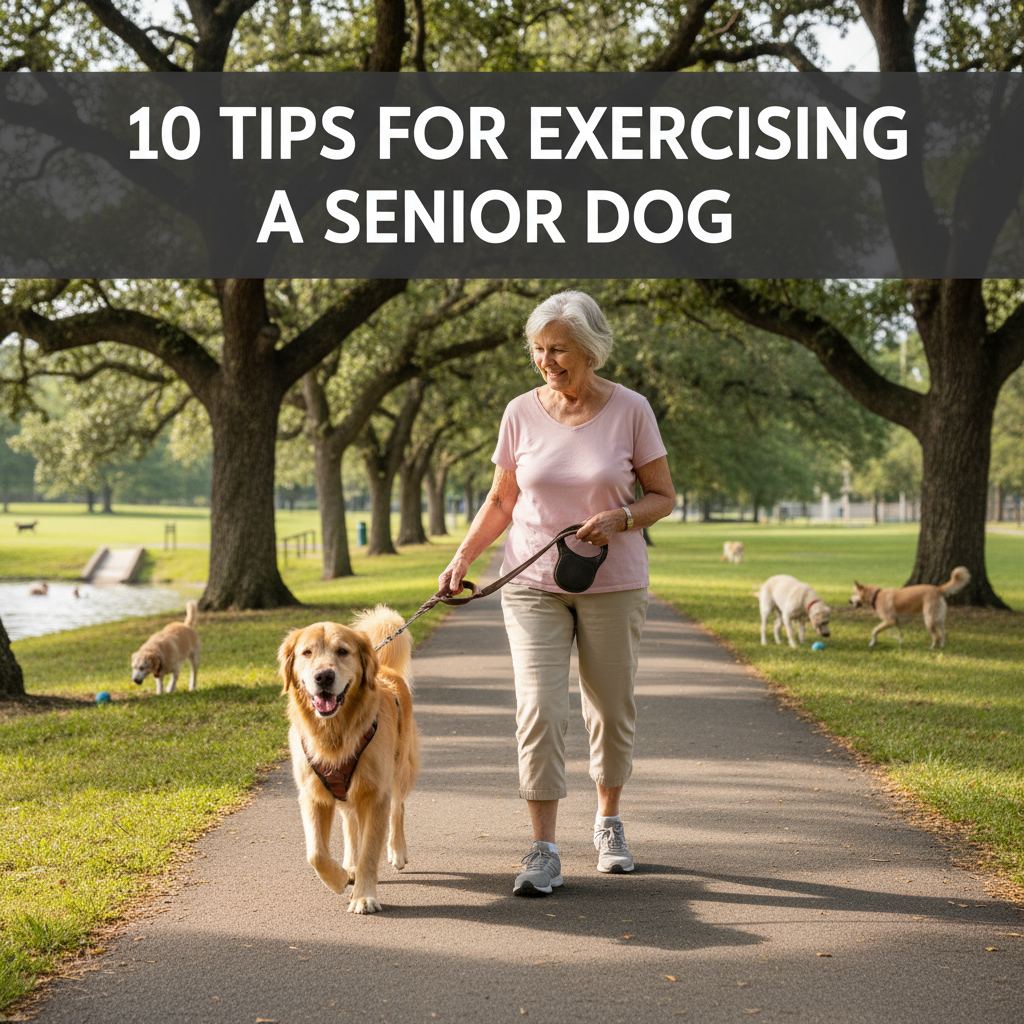10 Tips For Exercising a Senior Dog
Estimated reading time: 5 minutes
Key Takeaways
- Consult your veterinarian before starting any exercise program.
- Introduce routines gradually to accommodate your senior dog’s changing abilities.
- Focus on low-impact, shorter, and more frequent exercise sessions.
- Include mental stimulation in addition to physical activities.
- Create positive associations with exercise to encourage regular activity.
Table of Contents
- Consult Your Veterinarian First
- Start Slow and Monitor Closely
- Prioritize Low-Impact Activities
- Switch to Shorter, More Frequent Walks
- Incorporate Warm-Ups and Cool-Downs
- Use Gentle Strengthening and Balance Exercises
- Choose Softer Walking Surfaces
- Add Mental Stimulation
- Be Observant and Flexible
- Make Exercise Positive
- Additional Tips
- Key Takeaway
Consult Your Veterinarian First
Before embarking on any new exercise regime, it’s vital to consult your veterinarian. As every dog ages differently, a thorough check-up can screen for underlying health issues and provide safety recommendations tailored to your dog’s condition. Your vet will be able to suggest suitable activities and establish appropriate limitations based on your dog’s age, breed, and health history (source). Prioritizing your pet’s health ensures that your exercise plans are beneficial and safe, accommodating any nuances that may affect their capacity for activity.
Start Slow and Monitor Closely
When introducing an exercise routine to a senior dog, it’s crucial to start gradually. Begin with gentle, short sessions, allowing your dog to develop strength and endurance. For instance, a 5 to 10-minute walk around the yard can serve as an excellent starting point. As your dog becomes accustomed, you can gradually increase the intensity or duration of these sessions while keeping a watchful eye for signs of fatigue or discomfort. Senior dogs often cannot handle exercise levels they once could, so being attentive to their physical responses is paramount (source).
Prioritize Low-Impact Activities
As dogs age, their joints become more susceptible to stress, thereby increasing the risk of injury. To keep your senior dog active without overexerting them, focus on low-impact activities. These can include walking on softer surfaces like grass or sand, swimming, or engaging in play that involves controlled, gentle movements. High-impact exercises and hard surfaces can exacerbate health conditions such as arthritis, so steering clear of these is advisable (source); (source).
Switch to Shorter, More Frequent Walks
Long, strenuous walks can be taxing on senior dogs. Instead, opt for multiple shorter walks throughout the day, each lasting about 10 to 15 minutes. This approach not only caters to their energy levels but can also maintain a daily routine, which is crucial for your dog’s comfort and mental well-being. Consistent daily exercise promotes mobility and an overall sense of stability for aging dogs (source); (source).
Incorporate Warm-Ups and Cool-Downs
Just like humans, dogs need warm-up and cool-downs to prevent injuries. Before beginning an exercise session, allow your dog to ease into the activity with a brief warm-up, which can involve walking slowly around your yard or doing some gentle stretches. Similarly, end each exercise session with a cool-down, allowing your dog to gradually reduce their activity level. This method helps prevent stiffness and supports recovery after physical exertion (source).
Use Gentle Strengthening and Balance Exercises
Incorporating specific strengthening exercises can be highly beneficial. Activities like cavalettis (stepping over low poles), standing planks, and cookie stretches can enhance your dog’s balance and flexibility while being gentle on their body. You may also include low-platform standing exercises that support joint strength without excessive wear on aging joints (source).
Choose Softer Walking Surfaces
Creating a comfortable experience for your dog involves thoughtful selection of walking surfaces. Favoring softer terrains like grass, sand, or dirt can greatly reduce the impact on your senior dog’s aging joints. These types of surfaces can minimize their risk of injury, while also enhancing their enjoyment of outdoor activities (source); (source).
Add Mental Stimulation
Remember that exercising a senior dog isn’t just about physical activity; mental engagement is equally important. As physical capabilities may decline, mental stimulation can help maintain sharpness and reduce anxiety. Incorporate activities like treat puzzles, hide-and-seek games, and scent work to keep your dog mentally agile. This forms a necessary aspect of their exercise routine that nurtures their emotional well-being (source); (source).
Be Observant and Flexible
It’s essential to be perceptive of your dog’s physical and emotional responses during exercise. Watch for any signs of pain, limping, or reluctance, and adjust your activities accordingly. Senior dogs can experience fluctuations in their daily capability, necessitating a flexible approach to their exercise plans. Being adaptable to your dog’s needs will ensure they can maintain a joyful and active lifestyle without unnecessary strain (source).
Make Exercise Positive
To foster a love for exercise, create positive associations with activity. Encourage your dog with praise, gentle petting, or small treats to keep their motivation high. Cultivating a cheerful and enjoyable exercise environment helps reinforce routine activity while also strengthening the bond between you and your furry friend (source).
Additional Tips
- Avoid exercise during extreme temperatures; always exercise in moderate weather and use protective clothing as needed (source).
- Consider utilizing massage and gentle stretching techniques to enhance flexibility, especially in dogs suffering from arthritis (source).
- Consistency is key: ensuring regular, daily exercise is more beneficial than sporadic and intense activity sessions (source).
Key Takeaway
The primary focus when exercising a senior dog should be safety, comfort, and consistency. Balancing physical workouts with mental engagement will not only help maintain their physical condition but also greatly enhance their overall quality of life. Remember, a little effort can lead to increased longevity and joy for your furry friend.
At Your Company Name, we specialize in pet consulting and understand the unique needs of senior animals. Our team is dedicated to helping pet owners navigate the complexities of pet care, particularly for older dogs. Explore our services or contact us today for tailored advice on managing your senior dog’s health and well-being! Visit Your Website Link to learn more.
